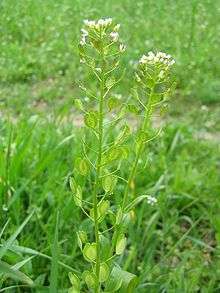Thlaspi arvense
| Thlaspi arvense | |
|---|---|
 | |
| Scientific classification | |
| Kingdom: | Plantae |
| (unranked): | Angiosperms |
| (unranked): | Eudicots |
| (unranked): | Rosids |
| Order: | Brassicales |
| Family: | Brassicaceae |
| Genus: | Thlaspi |
| Species: | T. arvense |
| Binomial name | |
| Thlaspi arvense | |
Thlaspi arvense, known by the common name field pennycress,[1] is a flowering plant in the cabbage family Brassicaceae.
Description
A foetid, hairless annual plant, growing up to 60 cm (24 in) tall,[2]:421 with upright branches. The stem leaves are arrow-shaped, narrow and toothed. It blooms between May and July, with clusters of small white flowers. They have 4 sepals and 4 longer petals.[3] Later it has round, flat, winged pods with a deep apical notch,[2]:421 measuring 1–1 cm (0.39–0.39 in)across. They contain small brown-black seeds.[3]
Taxonomy
The common name 'penny cress' is derived from the shape of the seeds looking like an old English penny.[3]
Distribution
It is native to temperate regions of Eurasia, but is a naturalized introduced species throughout temperate North America and therefore has a circumpolar distribution. In the British Isles it is regarded as an archaeophyte (an ancient introduction).[4]
Ecology
Field pennycress is a weed of cultivated land and wasteland.[4]
Edible uses
The field pennycress has a bitter taste; it is usually parboiled to remove the bitter taste. This is mostly used in salads, sometimes in sandwich spreads. It is said to have a distinctive flavour.[5]
Use as a source of biodiesel
Pennycress is being developed as an oilseed crop for production of renewable fuels.[6][7] The species can be planted in the fall, will germinate and form a vegetative mass which can overwinter. In the spring, the oil-rich seed can be harvested and used as a biodiesel feedstock.
Research
Pennycress is related to the model plant species Arabidopsis thaliana. Researchers have begun studying the genetics of pennycress in order to improve its potential use as a biofuel crop. For example, the transcriptome of pennycress has been sequenced.[8]

References
- ↑ "Thlaspi arvensis". Natural Resources Conservation Service PLANTS Database. USDA. Retrieved 9 December 2015.
- 1 2 Stace, C. A. (2010). New Flora of the British Isles (Third ed.). Cambridge, U.K.: Cambridge University Press. ISBN 9780521707725.
- 1 2 3 Reader's Digest Field Guide to the Wild Flowers of Britain. Reader's Digest. 1981. p. 53. ISBN 9780276002175.
- 1 2 "Online Atlas of the British & Irish flora: Thlaspi arvense, Field pennycress". London, U.K.: Biological Records Centre and Botanical Society of Britain and Ireland. Retrieved 29 May 2016.
- ↑ "Field Pennycress Thlaspi arvense". ediblewildfood.com. Retrieved 1 December 2017.
- ↑ Arvegenix LLC website
- ↑ Field pennycress shows feedstock potential
- ↑ De novo assembly of the pennycress (Thlaspi arvense) transcriptome provides tools for the development of a winter cover crop and biodiesel feedstock. Kevin M. Dorn, Johnathon D. Fankhauser, Donald L. Wyse, M. David Marks. The Plant Journal. doi:10.1111/tpj.12267